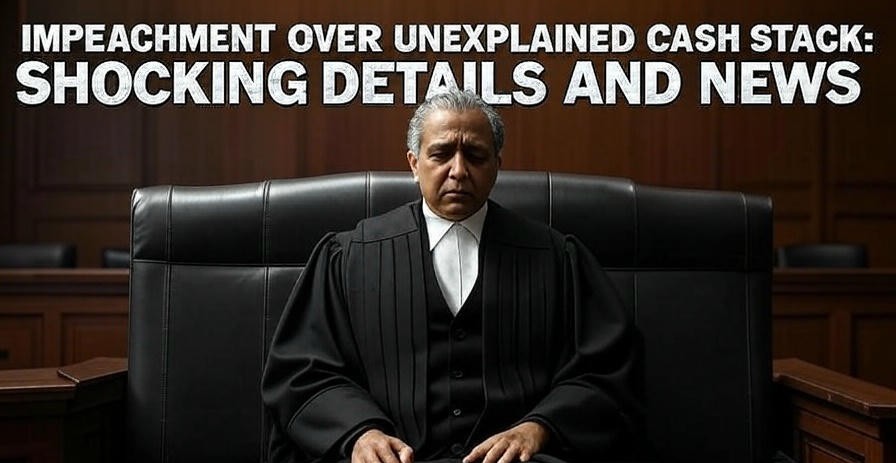INTRODUCTION
According to the committee’s findings, which was established by the Supreme Court, Justice Yashwant Varma was accused of misbehavior that was serious enough to warrant the start of impeachment proceedings. High Court judge Justice Yashwant Varma is facing severe consequences when burned bundles of cash were discovered at his Delhi residence.
Because he was unable to provide an explanation for the money’s source, an investigating commission constituted by the Supreme Court has now suggested that he be impeached.
The surprising news and facts of the 1.5-foot unexplained cash stack discovered with Justice Yashwant Varma are examined in this article. It will research the procedure of impeachment.
THE HISTORY OF THIS CASE
Justice Yashwant Varma’s official apartment in the 30-Tughlak Crescent neighborhood of Delhi caught fire on March 14. Authorities discovered massive piles of burned money in his home’s storeroom after the fire was put out. The inquiry report, which India Today was able to see, stated that the money was strewn all over the room and reached a height of 1.5 feet.
According to the report, “the fact that the burned cash was discovered in the store room was undeniably established, so the burden shifted upon Justice Varma to account for the said cash by giving a plausible explanation, which he failed to do except raising a plea of conspiracy and projecting a case of flat denial.”
According to the report, the judge’s daughter was among the 17 people who spent the night of March 14–15 at his home. According to reports, Justice Varma and his family were in “covert” and “active” management of the storeroom where the cash was discovered. Additionally, because the storage was kept secured and only the judge and his immediate family could enter, the panel disregarded the involvement of any outsiders.
In his testimony, the SHO of the Tughlaq Nagar Police Station stated that the pile of burned money on the ground was almost one and a half feet high. The ledge also held a 1.5-foot stack of partially burned banknotes. According to the report, the witness also reported that the money notes were spread out on the floor between the storehouse’s door and the wall on the other side. Additionally, a liquor cupboard next to a switchboard allegedly exacerbated the fire. After the incident, the Justice Varma staff even attempted to remove the burned cash.
Rajender Singh Karki, the judge’s secretary, is also highlighted in the report for his conduct. He called Justice Varma throughout the night to give him information and was the first to alert him of the fire.
ACCORDING TO JUSTICE VARMA
Justice Varma made a “flat denial” and claimed that there was a “conspiracy” against him rather than providing a thorough explanation. However, this explanation was not accepted by the committee.
The report said, “This committee is formally of the view that there is sufficient substance in the allegations and the misconduct found proved is serious enough to call for the initiation of proceedings for removal of Justice Yashwant Varma, keeping in mind the direct and electronic evidence on record.”
REPORT FINDINGS
Justice Varma and his family had active or covert control over the chamber where the cash was found. Yashwant Varma’s wrongdoing was deemed severe enough to warrant his impeachment.
Since it is now known that unaccounted money was found at Justice Varma’s home, he must provide a reasonable explanation. Varma had repeatedly denied the accusations against him, claiming that anyone could enter the room where the money was found.
The cash was discovered in a chamber inside Varma’s residence at 30, Tughlak Crescent, New Delhi. On March 15, his most dependable domestic workers played a crucial role in clearing the room of burned money.
ACTIONS OF THE SUPREME COURT
Justice Varma was then moved from the Delhi High Court to the Allahabad High Court by the Supreme Court. He hasn’t been assigned any new judicial duties, though. Additionally, the Court denied motions to register a First Information Report (FIR) in this instance, stating that the government should now make the final decision.
The inquiry report was sent to the Prime Minister and the President by Sanjiv Khanna, who was India’s Chief Justice at the time. Only when the allegations are deemed serious enough to warrant removal and the judge declines to step down is this done.
CONCLUSION
A judge may only be dismissed under the Constitution for “proven misbehavior or incapacity.” A motion must be approved by the Rajya Sabha and the Lok Sabha.
It requires a majority of each House’s whole membership and Two-thirds of those in attendance and casting ballots.
Only if the President issues the order during the same session does the final dismissal take place. During the next monsoon session, the administration of Prime Minister Narendra Modi is expected to file an impeachment move against Justice Yashwant Varma, a former judge on the Delhi High Court, in the cash at house case. The action comes after the Supreme Court’s own inquiry panel indicted Justive Varma.

